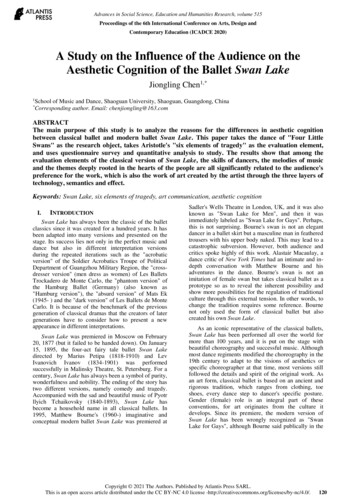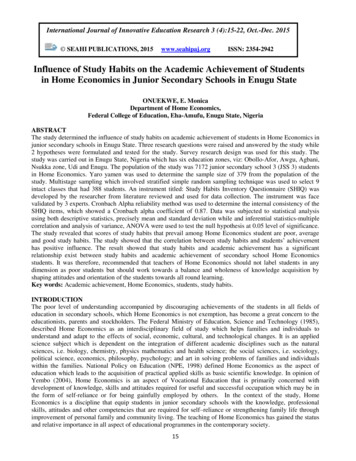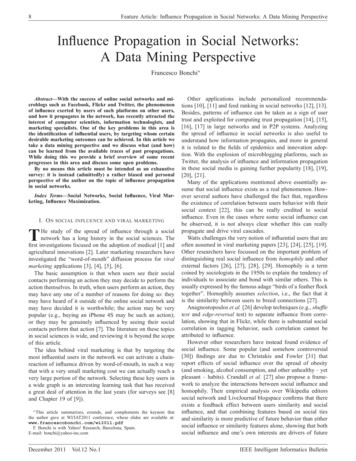
Transcription
Advances in Social Science, Education and Humanities Research, volume 515Proceedings of the 6th International Conference on Arts, Design andContemporary Education (ICADCE 2020)A Study on the Influence of the Audience on theAesthetic Cognition of the Ballet Swan LakeJiongling Chen1,*1*School of Music and Dance, Shaoguan University, Shaoguan, Guangdong, ChinaCorresponding author. Email: chenjiongling@163.comABSTRACTThe main purpose of this study is to analyze the reasons for the differences in aesthetic cognitionbetween classical ballet and modern ballet Swan Lake. This paper takes the dance of "Four LittleSwans" as the research object, takes Aristotle's "six elements of tragedy" as the evaluation element,and uses questionnaire survey and quantitative analysis to study. The results show that among theevaluation elements of the classical version of Swan Lake, the skills of dancers, the melodies of musicand the themes deeply rooted in the hearts of the people are all significantly related to the audience'spreference for the work, which is also the work of art created by the artist through the three layers oftechnology, semantics and effect.Keywords: Swan Lake, six elements of tragedy, art communication, aesthetic cognitionI.INTRODUCTIONSwan Lake has always been the classic of the balletclassics since it was created for a hundred years. It hasbeen adapted into many versions and presented on thestage. Its success lies not only in the perfect music anddance but also in different interpretation versionsduring the repeated iterations such as the "acrobaticversion" of the Soldier Acrobatics Troupe of PoliticalDepartment of Guangzhou Military Region, the "crossdresser version" (men dress as women) of Les BalletsTrockadero de Monte Carlo, the "phantom version" ofthe Hamburg Ballet (Germany) (also known as"Hamburg version"), the "absurd version" of Mats Ek(1945- ) and the "dark version" of Les Ballets de MonteCarlo. It is because of the benchmark of the previousgeneration of classical dramas that the creators of latergenerations have to consider how to present a newappearance in different interpretations.Swan Lake was premiered in Moscow on February20, 1877 (but it failed to be handed down). On January15, 1895, the four-act fairy tale ballet Swan Lakedirected by Marius Petipa (1818-1910) and LevIvanovich Ivanov (1834-1901) was performedsuccessfully in Malinsky Theatre, St. Petersburg. For acentury, Swan Lake has always been a symbol of purity,wonderfulness and nobility. The ending of the story hastwo different versions, namely comedy and tragedy.Accompanied with the sad and beautiful music of Pyotrllyich Tchaikovsky (1840-1893), Swan Lake hasbecome a household name in all classical ballets. In1995, Matthew Bourne's (1960-) imaginative andconceptual modern ballet Swan Lake was premiered atSadler's Wells Theatre in London, UK, and it was alsoknown as "Swan Lake for Men", and then it wasimmediately labeled as "Swan Lake for Gays". Perhaps,this is not surprising. Bourne's swan is not an elegantdancer in a ballet skirt but a masculine man in featheredtrousers with his upper body naked. This may lead to acatastrophic subversion. However, both audience andcritics spoke highly of this work. Alastair Macaulay, adance critic of New York Times had an intimate and indepth conversation with Matthew Bourne and hisadventures in the dance. Bourne's swan is not animitation of female swan but takes classical ballet as aprototype so as to reveal the inherent possibility andshow more possibilities for the regulation of traditionalculture through this external tension. In other words, tochange the tradition requires some reference. Bournenot only used the form of classical ballet but alsocreated his own Swan Lake.As an iconic representative of the classical ballets,Swan Lake has been performed all over the world formore than 100 years, and it is put on the stage withbeautiful choreography and successful music. Althoughmost dance regiments modified the choreography in the19th century to adapt to the visions of aesthetics orspecific choreographer at that time, most versions stillfollowed the details and spirit of the original work. Asan art form, classical ballet is based on an ancient andrigorous tradition, which ranges from clothing, toeshoes, every dance step to dancer's specific posture.Gender (female) role is an integral part of theseconventions, for art originates from the culture itdevelops. Since its premiere, the modern version ofSwan Lake has been wrongly recognized as "SwanLake for Gays", although Bourne said publically in theCopyright 2021 The Authors. Published by Atlantis Press SARL.This is an open access article distributed under the CC BY-NC 4.0 license 0
Advances in Social Science, Education and Humanities Research, volume 515early days that it was not homosexual, or homosexualelements were subject to human loneliness and the needfor love, which was a bigger emotional andphilosophical issue. As a director and choreographer, herecreated the story with a contemporary backgroundcorrelated to reality. Meanwhile, he used symbolicscenes, lighting, actions and even some humoroustechniques to push this "leap" to the height of art.As a model, the classical ballet Swan Lake is aperfect performance model for others, presenting aspecific identity and a specific dance form. In societyand classical ballet, it is usually strictly dividedaccording to gender, but Bourne's swans are allperformed by men, and the protagonist is also changedfrom a princess to a prince. The prince is not a hero buta vulnerable and helpless person, which greatly changesthe strict convention of gender and deconstructs theideology and formal structure of classical ballet. Inparticular, controversial issues, such as homosexuallove and Oedipus plot (despite only a part of it),provide ballet with "practical significance" — reflectionon human nature. It can be said that Bourne's SwanLake is also a model connecting on-stage (fiction) andoff-stage (reality) and the emotion between dancers andaudience. However, this kind of "subversion" isdifferent from the classical version. It also reminds theaudience that the concept of "subversion" is not unitary,and its possibilities and contributions will be diverse.Therefore, the main purpose of this paper is to exploreand analyze the differences of the audience's aestheticcognitions and preferences for the classical version ofballet and the modern version of Swan Lake and howthe audience can appreciate the work through technicallevel, semantic level and effect level and what kind ofaesthetic experience can be brought to the audience bythe works with the same image and different themes.II.LITERATURE DISCUSSIONA. "Six elements of tragedy" of AristotleAristotle (384-322 B.C.) defined "tragedy" in hisOn the Art of Poetry (translated by Chen, Z. M. 1996)[1]: "Tragedy, then, is an imitation of an action that isserious, complete, and of a certain magnitude; inlanguage embellished with each kind of artisticornament, the several kinds being found in separateparts of the play; in the form of action, not of narrative;through pity and fear effecting the proper purgation ofthese emotions." He expounded the formation oftragedy in a historical and local way. We can see thattragedy itself is a complex whole rather than a simpleindividual. Then, he analyzed the definition anddiscussed the "six elements of tragedy". Specifically,these six elements include: plot, character, thought,diction, melody and spectacle. Aristotle held that plotwas the root of tragedy and the soul of tragedy, for thepurpose of tragedy was an imitation of "an action that isserious, complete, and of a certain magnitude". In theplot requirements, "serious" is the difference betweentragedy and comedy, that is, it must imitate seriousevents rather than joking events. "Complete" means thatthe plot of a tragedy should have beginning,development and ending. There should be a reasonableconnection and a natural transition among these threeparts. "Of a certain magnitude" means that the plot of atragedy should be neither too short nor too long. Inmass culture and literary works, tragedy has become asymbol of "death", that is, it contains the remarkablecharacteristics of great men/women, regrets and falls oftragedy. On the contrary, tragedy explores the role ofaudience (viewers) in paying attention to tragic heroes.They enjoy a lofty status in the drama and have someshortcomings in personality. The performance of theplot is mostly complex and depicts human nature. Thecontent is also of great significance. Tragedy is not onlyabout great men but also about small potatoes.B. Communication mode of artistic creationGoldman (2004) [2] proposed that the evaluation ofartistic works required a profound understanding on thecommunication mode between artists and audience. It isnot only a demand in the social context but also forunderstanding the emotional cognition and experiencebetween the creators and the viewers. The processabout how an artist expresses artistic creation is calledas encode, and the process about how the audienceunderstand the artistic works is called as decode. As faras the formulaic school of communication theory isconcerned and in the communication process from theartistic works creation of the artist (sender) to theaudience (receiver), the connotation of a successfulartistic works should meet three levels: technical level,semantic level and effect level (Lin, C. L., Chen, J. L.,Chen, S. J., Lin, R.,2015) [3]. (1) At the technicallevel, the audience should be able to perceive theartistic works vividly and make the audience see them.(2) At the technical level, the audience shouldunderstand the meaning of the artistic works and makethe audience understand them. (3) At the effect level,the audience should be able to understand the artisticworks and make the audience moved. Throughliterature review, combining communication, cognitivetheory and "six elements of tragedy" of Aristotle.Proposing a communication mode between dancedrama artistic creation communication and audience'saesthetic cognition, which is summarized as "cognitivemodel of ballet art creation", as shown in "Fig. 1",which is the basis elements of the subsequentevaluation framework of aesthetic cognition.121
Advances in Social Science, Education and Humanities Research, volume 515Fig. 1. Cognitive model of ballet art creation.III.RESEARCH METHODSIV.In this study, "six elements of tragedy" of Aristotlewere taken as the attribute for questionnaire design, theaudience who watched the dance of "Four Little Swans"in the classical version and modern version of SwanLake were taken as the subjects. Online questionnaireswere sent out, and a total of 191 valid questionnaireswere recycled. Among them, 28 (14.7%)were male and163 (85.3%) were female; the age groups were dividedinto: 30 people (15.7%) below 20 years old, 111people(58.1%) between 21-30 years old, 25 people (13.0%)between 31-40 years old, 15 people (7.9%) between 4150 years old and 10 people (5.3%) above 51 years old.There were 155 people (81.2%) holding a bachelor'sdegree, 24 (12.5%) holding a master's degree or aboveand 12 (6.3%) for other education background. Therewere 80 people (41.9%) from dance field, 54 (28.3%)from music field, 6 (3.1%) from other art fields and 51(26.7%) from non-art fields. At technical, semantic andeffect levels, dance language, dance scene, music in thedrama, character, tragic plot and thought were theevaluation factors. In addition, the overall scores ofinnovation and creativity and preference for the workwere added for designing the questionnaire, and theLikert scale (1 is the lowest and 5 is the highest) is usedfor questionnaire survey (questionnaire URL:https://www.wjx.cn/jq/40361348.aspx).TABLE I.RESEARCH RESULTSA. Analyses of validity and reliabilityThe audience's decoding of the dance of "Four LittleSwans" needed to be studied according to theevaluation framework. Combined with 6 attributes and12 key factors in the evaluation framework, 28questions were proposed to evaluate the overallimpression of the performance. It could be divided intothree categories according to technical level, semanticlevel and effect level. In particular, Questions 5-8 (1922) were based on attribute of dance language anddance scene, Questions 9-12 (23-26) were based onmusic and characters in the drama, Questions 13-16(27-30) were based on tragic plot and thought, andQuestions 17-18 (31-32) were the evaluation of theoverall dance. That was, the intensity of innovation andcreativity and the preference of the work. According to"Table I", the overall reliability of the observationquestionnaire was analyzed. The reliability coefficientof the "classical version" Cronbachα was .940, thecorrected total correlation was from .622 to .817, and "αcoefficient after deletion" case was from .931 to .939.The reliability coefficient of the "modern version"Cronbachα was .932, the corrected total correlationsituation was from .549 to .849, and "α coefficient afterdeletion" was from .921 to .932. Therefore, thereliability of the research data was very high.EVALUATION FRAMEWORK OF AESTHETIC COGNITION OF "FOUR LITTLE SWANS" IN SWAN LAKEPerception ProcessArtist(Coding)Technical level ASemantic level BEffect level CDance languageA1-1A1-2Graceful movementsSuperb technologyMusic in the dramaB1-1B1-2Beautiful melodyHappy rhythmTragic plotC1-1The plot is movingDance sceneA2-1A2-2Gorgeous clothesExquisite danceCharacterB2-1B2-2Exquisite emotionDistinctive personalityThoughtC2-1C1-2C2-2Win support amongStimulate imaginationThought-provokingthe peopleAudience(Decoding code)Aesthetic experienceExternal levelIntermediate levelInternal level122
Advances in Social Science, Education and Humanities Research, volume 515In order to test the validity analysis of theevaluation framework, the KMO coefficient of the"classical version" was .928, which had a very highvalue. The Sig value was .000, which was significant.The eigenvalue was 7.286, which could explain60.714% variation of the preset purposes. The loadcapacity of each factor was from .685 to .851, and thecommonality was from .469 to .724. The KMOcoefficient of the "modern version" was .903, whichhad a very high value. The Sig value was .000, whichwas significant. The eigenvalue was 6.923, which couldexplain 57.693% variation of the preset purposes. TheTABLE II.load capacity of each factor was from 0.610 to .883,and the commonality was from .372 to .780.B. Analysis of key factors1) Analysis of average scores of preference andinnovation and creativity: As shown in "Table II", theresults showed that the audience's preference for theclassical version was higher than that of the modernversion, while the modern version was more innovativeand creative than the classical version.ANALYSIS TABLE OF THE AVERAGE SCORES OF PREFERENCE AND INNOVATION AND CREATIVITY AVERAGESVersionMean value of innovation and creativity (M)Mean value of preference (M)Classical version3.814.09Modern version4.313.752) Analysis of the influence of innovation andcreativity on preference: As shown in "Table III", theresults showed that the score of innovation andcreativity was significantly correlated with the score ofpreference. In particular, 5 people obtained 1 point inthe "classical version", 11 people obtained 2 points, 58people obtained 3 points, 59 people obtained 4 points,and 58 people obtained 5 points. There were a total of191 people. There was a significant positive correlationbetween the score of innovation and creativity and theTABLE III.ANALYSIS TABLE OF THE INFLUENCE OF INNOVATION AND CREATIVITY ON PREFERENCE (ANOVA)VersionFunctional levelClassical versionInnovation and creativity of worksModern versionscore of preference (5 points 4 points 3 points 2points 1 point). 2 people obtained 1 point in the"modern version" (As the number of people was lessthan 5, so this item was not included in the survey), 5people obtained 2 points, 17 people obtained 3 points,75 people obtained 4 points, and 92 people obtained 5points. There were a total of 191 people. There was asignificant positive correlation between the score ofinnovation and creativity and the score of preference (5points 4 points 3 points 2 points).Innovation and creativity of worksSourceSSDFMSBetween Groups81.566420.392Within Groups73.920186.397Total155.487190Between Groups46.304411.576Within **5 4 3 2 118.701***5 4 3 2a.3) Analysis of influence factors of preference: Asshown in "Table IV" and according to the multipleregression analysis in the table below, the correlationcoefficient R between the overall prediction variableand the dependent variable in the classical versionwas .818. The explained variance of 12 predictivevariables v.s. "dance preference" was 66.9%, and the Fvalue was 30.024 and reached the significant levelof .001. In particular, the most important significantprediction variables were as follows: The β value of"the dancer is skilled" was .293, reaching the significantlevel of .001. The β value of "the melody is pleasant"***p .001.was .211, reaching a significant level of .01, and the βvalue of "the theme enjoys popular support" was .221,reaching a significant level of .01. The correlationcoefficient R between the overall prediction variableand the dependent variable in the modern versionwas .769. The explained variance of 12 predictivevariables v.s. "dance preference" was 59.1%, and the Fvalue was 19.671 and reached the significant levelof .001. In particular, the most important significantprediction variable was as follows: The β value of "thedancer's movements are graceful" was .149, reaching asignificant level of .05.123
Advances in Social Science, Education and Humanities Research, volume 515TABLE IV.VersionREGRESSION ANALYSIS TABLE OF INFLUENCE FACTORS OF PREFERENCEBβTA1-2 The dancer is skilled.293.2503.541***B1-1 The melody is pleasant.211.1822.716**C2-1 The theme enjoys popular support.221.2543.154**.149.1532.131*Dependent variableClassical versionPreference for the workPrediction variableR .818 Rsq .669 F 30.024***Modern versionPreference for the workA1-1 The dancer's movements are graceful.R .769 Rsq .591 F 19.671***a.As shown in "Table V", it could be seen bycomparing the mean values of 4 attributes which weresignificantly correlated to the results that the score ofthe classical version was higher than that of the modernversion. It could be seen by ranking the mean values of12 influencing attributes of the two versions that 3attributes which were significantly correlated to theTABLE V.Classical version*P .05, **P .01, ***P .001preference of the classical version ranked the top fivepositions. This indicated that the audience had a highrecognition for these three attributes. 1 attribute whichwas significantly correlated to the preference of themodern version ranked the 11th position, indicating thatthe audience had a low recognition for this attribute.COMPARISON OF THE MEAN VALUES OF 12 ATTRIBUTESA1-2The dancer isskilled.A1-1The dancer's movementsare graceful.B1-1The melody ispleasant.C2-1The theme enjoyspopular support.4.294.264.424.06Score ranking3425Modern version4.053.504.163.81Score ranking51137C. Relationship between subjects' backgrounds andcognitive factors1) Influence of gender on cognitive factors: In thisstudy, 28 male and 163 female subjects were selectedand tested according to each dimension. Theindependent sample t-test was used to analyze andcheck whether there was any significant difference ingender between the classical version and the modernTABLE VI.Versionversion. In terms of "the stage art design is delicate",male subjects obtained a score of 3.39 and femalesubjects obtained a score of 3.63. In terms of "thecharacter emotion is expressed exquisitely", malesubjects obtained a score of 3.61 and female subjectsobtained a score of 3.78. As shown in "Table VI", thescore of women was higher than that of men.TABLE OF THE DIFFERENCES OF THE SUBJECTS (MALE/FEMALE) IN ATTRIBUTE COGNITIONFunctional levelA2-2The stage art design is emale maleFemale1633.63.929Male283.611.197-.728*Female maleFemale1633.78.868Modern versionB2-1The character emotion is expressed exquisitely.a.As the gender ratio of the subjects was uneven andwomen were more than men, it could be seen from theselection influence analysis of gender differences*p .05.showed that 3 attributes affecting the preference forclassical version and 1 attribute affecting the preference124
Advances in Social Science, Education and Humanities Research, volume 515for modern version were not significantly affected bygender.2) Influence of age, educational background andprofessional background on cognitive factors: Aftervariance difference was tested, no significant differencewas found in age and educational background, but itwas significant in professional background. Thesamples included 80 people from dance field, 54 frommusic field, 6 from other art fields and 51 from non-artfields. According to the ANOVA analysis ofindependent samples, there was a significant differencein the attribute evaluation of "characters with distinctTABLE VII.personality" in the classical version, and the scores ofdance, music, other art and non-art fields were 4.04,3.80, 3.83 and 3.49 respectively; there was a significantdifference in the attribute evaluation of "innovation andcreativity", and the scores of dance, music, other art andnon-art fields were 4.00, 3.89, 3.33 and 3.47respectively; there was a significant difference in theattribute evaluation of "preference for the work", andthe scores of dance, music, other art and non-art fieldswere 3.78, 3.52, 2.50 and 3.53 respectively. After thedifferent test, the F value was 3.663*.TABLE OF THE ATTRIBUTE COGNITION DIFFERENCES OF THE SUBJECTS (WITH OR WITHOUT THE DANCE OR ART BACKGROUND)VersionFunctional levelB2-2Characters with distinct personalityClassical versionInnovation and creativityPreference for the workModern versionA2-2The stage art design is delicate.SourceSSDFMSBetween Groups9.36133.120Within Groups191.2251871.023Total200.586190Between Groups10.46033.487Within Groups187.3731871.002Total197.832190Between Groups7.86232.621Within Groups147.625187.789Total155.487190Between Groups10.32133.440Within 1 43.480*1 43.320*3.663*1 2a.V.CONCLUSIONWhy are some ballets particularly attractive andpopular? What are the influence factors? At the stage ofcreation and design, the director should know how toapply these factors to make the audience feel andunderstand the ideas conveyed through the works. Forthe audience, apart from aesthetic experience orabsorption of new knowledge, they need to obtainenrichment and satisfaction in spiritual and sensoryexperience. Therefore, we must focus on understandingthe audience's real feelings after appreciation so as toachieve optimal presentation. Using "six elements oftragedy" of Aristotle to help establish the above model,it is effective to explore the audience's cognition for"Four Little Swans" in Swan Lake, and the researchresults reflect the different aesthetic cognition of theaudience for the two versions. The results are asfollows: From the analysis of preference and the meanvalue of innovation and creativity and the*p .05.influence of innovation and creativity onpreference, it can be seen that there is asignificantpositivecorrelationbetweenpreference and innovation and creativity, but theworks that are more popular among the audienceand considered by the audience to be moreinnovative and creative are not the same. It canbe seen that in addition to innovation andcreativity, there are other factors affecting thepreference for the work. As Nietzsche (1996) [4]said, "The symbol of originality is not todiscover the new things but treat the old,familiar, seen but ignored things as the newones". Therefore, the innovation of dance shouldbe integrated with the regression of dance. From the influence factors of preference, it canbe seen that "the dancer is skilled", "the melodyis pleasant" and "the theme enjoys popularsupport" in the classical version, and "thedancer's movements are graceful" in the modernversion significantly affects the audience's125
Advances in Social Science, Education and Humanities Research, volume 515preference. Among them, the "the dancer isskilled" in the classical version belongs to thetechnical level, "the melody is pleasant" belongsto the semantic level, and "the theme enjoyspopular support" belongs to the effect level,showing the three levels of artistic works createdby artists. The aesthetic experience is achievedafter skill performance. The two attributes of"the dancer is skilled" and "the dancer'smovements are graceful" belong to the technicallevel, and both of them have a significantinfluence on the preference for dance. It can beseen that this level has a more obvious influenceon the audience's preference than the other twolevels. It can be seen that the performer'sexpression at the technical level has attracted theattention of the audience. Human is the carrierof beauty. As John Martin (translated by Ou, J.P.1994) [8] said, "Human movement is indeedthe essence of life Besides its most obviousmovement function, action is the most activemedium of expression and cognition. Dancersuse their movements to express their thoughts,while the audiences use the action to understandthe thoughts." Action has its own meaning andthought. There are some differences in the cognition ofdance between different genders. There aresignificant differences between "the stage artdesign is delicate" and "the character emotion isexpressed exquisitely" in the modern version.The evaluation of women is significantly higherthan that of men, and women pay more attentionto stage art and emotional expression ofcharacters than men. In the modern version,"Four Little Swans" are not presented in theform of collective dance, but each little swan hasits own personality which is clumsy, aggressiveand sensitive. In the stage art design, manyelements are skillfully integrated, which canbring more abundant visual senses.backgrounds, which showed that the subjectswith these three backgrounds had a stricterevaluation standard for this attribute.References[1]Aristotle, "Poetics," Chen, Z. M, Trans. Beijing: TheCommercial Press, 1996, pp. 63.[2] Goldman, A., "The Blackwell guide to aesthetics," Evaluatingart, In P. Kivy, Eds. Malden, MA: Blackwell Publishing, 2004,pp.93-108.[3] Lin, C. L., Chen, J. L., Chen, S. J., & Lin, R, The cognition ofturning poetry into painting, Journal of US-China EducationReview B, vol.5(8). 2015, pp. 471-487.[4] Nietzsche, F, "Human, all too human: A book for free spirits,"M. Faber & S. Lehmann, Trans. Cambridge, England:Cambridge University Press, 1996.[5] Alastair Macaulay, Matthew Bourne, "Matthew Bourne and HisAdventures in Dance: Conversations with Alastair Macaulay,"London: Faber and Faber,2011.[6] Carter, Alexandra, "Rethinking dance history: a reader (AlastairMacaulay. Matthew Bourne, dance history and Swan Lake),"London, New York: Routledge. 2004, pp.157-169.[7] Juhasz, S., Queer Swans: Those Fabulous Avians in the SwanLakeS of Les Ballets Trockadero and Matthew Bourne, DanceChronicle, vol.31(1), 2008, pp.54–83.[8] John Martin, "The introduction to dance," Ou, J. P. Trans.Beijing: Culture and Art Publishing House, 1994.[9] Kant, I., "Critique of the power of judgment," P. Guyer & E.Matthews, Trans. Cambridge, England:CambridgeUniversity Press. 2000. (Original work published 1790)[10] Lin, R. T., & Lee, S. M., "Poetic and pictorial splendor," NewTaipei City: National Taiwan University of Arts, 2015.[11] Fang, W. T., Gao, Y.J., & Tseng, C. H., Lin, P. H., A Study onAudience Perception of Aesthetic Experience in DancePerformance, Journal of Design, vol. 23(3), 2018, pp. 23-46.[12] Zhu, L. R., "Selected works of modern western art aesthetics:Dance aesthetics," Taipei: Hongye culture, 1994. Different professional backgrounds havesignificantly different cognitions for dance. Inthe evaluation of the attributes of "characterswith distinct personality" and "innovation andcreativity" in the classical version and "the stageart design is delicate" in the modern version,professional dance background has higherevaluation, and there is a significant difference.Professional dancers have a higher standard forprofessional cognition of these three attributes.There are different concepts in the process ofperformance art creation and presentation. Interms of the evaluation of "preference for thework" in the classical version, those with otherartistic backgrounds give higher evaluationsthan those with dance, music and non-art126
Accompanied with the sad and beautiful music of Pyotr llyich Tchaikovsky (1840-1893), Swan Lake has become a household name in all classical ballets. In 1995, Matthew Bourne's (1960-) imaginative and conceptual modern ballet Swan Lake was premiered











